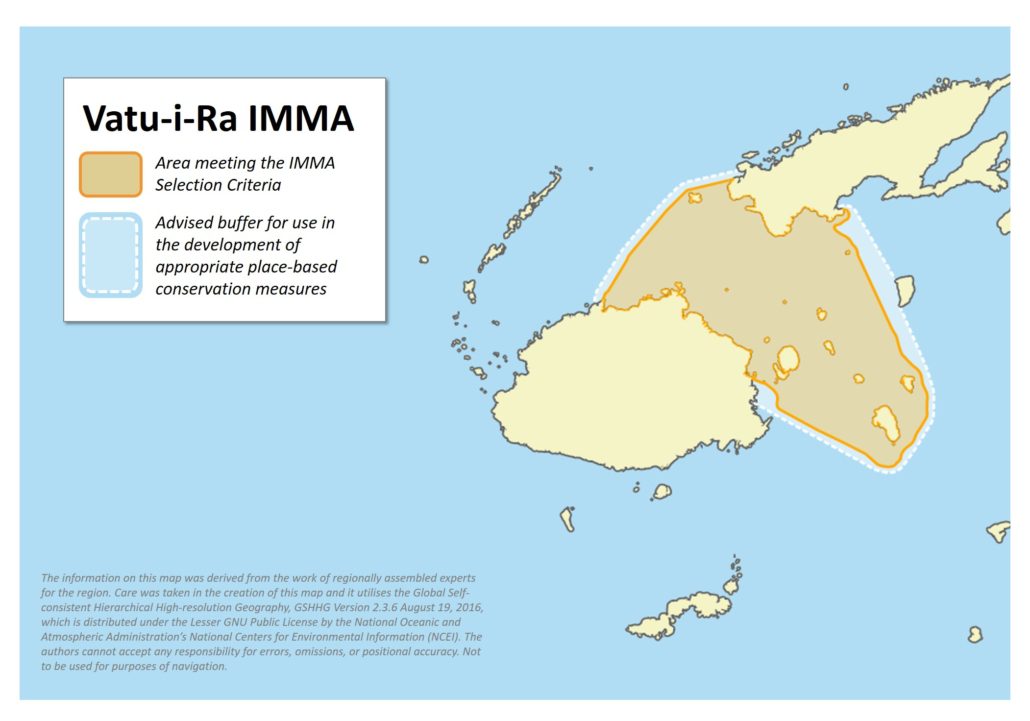Vatu-i-Ra IMMA
Area Size
14 293 km2
Qualifying Species and Criteria
Humpback Whale – Megaptera novaeangliae
Criterion A; C (1)
Spinner dolphin – Stenella longirostris
Criterion B (1); C (1)
Marine Mammal Diversity
Criterion D (2)
Globicephala macrorhynchus, Physeter macrocephalus, Pseudorca crassidens, Stenella attenuata, Tursiops truncatus, Balaenoptera acutorostrata, Orcinus orca
Download fact sheet
Summary
The Vatu-i-Ra (ViR) IMMA is a tropical marine system stretching between the two main islands (Viti Levu and Vanua Levu) of Fiji. The ViR IMMA is comprised of a variety of habitats including healthy coral reefs in the coastal areas, a deep canyon, and dynamic and productive oceanographic processes. The ViR has been documented to provide critical resting habitat for spinner dolphins, as well as calving habitat and a migration route for Endangered Oceania humpback whales. The culturally important sperm whale is also present within the ViR although in numbers much reduced as compared to pre-whaling times. Other cetacean species confirmed across this area include the short-finned pilot whale, pantropical spotted dolphin, and false killer whale.
Description of Qualifying Criteria
Criterion A – Species or Population Vulnerability
The Fiji humpback whale population belongs to the Oceania subpopulation which is classified as Endangered by IUCN (Childerhouse et al. 2008). The ViR IMMA is a documented breeding and calving ground for these whales. The most recent study carried out from 2010 – 2012 counted 33 individuals in 480 h (across a 3-year period) from Ovalau Island, and 68 individuals in approximately 300 h at a field site on Makogai Island. Presence of calves was documented during the surveys as well as re-sightings suggesting that the humpbacks tend to stay around the shallow reefs of the Lomaiviti islands.
Criterion B: Distribution and Abundance
Sub-criterion B1: Small and Resident Populations
Within the IMMA a small resident population of spinner dolphins (Stenella longirostris) has been documented as present regularly (Hunt, 2009; Cribb et al. 2012). The predictable presence of the spinner dolphins has made it a major draw for tourists. Photo-identification surveys and behavioural observations were conducted within the Moon Reef complex in 2009 and 2010. Analysis confirmed that most of the same individuals returned to Moon Reef daily. A pod of approximately 100 individuals has been documented as present in the area for 10 years and this appears to be a critical resting area for the spinner dolphins (Cribb et al. 2012).
Criterion C: Key Life Cycle Activities
Sub-criterion C1: Reproductive Areas
Within the ViR IMMA the presence of calves for both the species Stenella longirostris and Megaptera novaeangliae have indicated that it is a reproductive area. Calving of Endangered Oceania humpback whales has been reported in proximity to a number of reef systems and islands within the IMMA.
Sub-criterion D2: Diversity
There are regular and numerous sightings of, short-finned pilot whales, sperm whales, and dwarf minke whales across the IMMA. Additional species that have been confirmed include pantropical spotted dolphins, common bottlenose dolphin, diminutive sperm whale (believed to be a dwarf sperm whale), pygmy killer whale, and false killer whale. See Miller et al. 2016 for additional details on these species records.
Supporting Information
Batibasaga, A. and Sharma-Gounder, S. 2009. Preliminary survey of humpback whale migration from Makogai Island: 3rd September–18th September 2009. Fiji Fisheries Department, Suva, Fiji.
Batibasaga, A., and Sharma-Gounder, S. 2011. Research progress report: Establishing a long-term data set for monitoring trends in humpback whale migration through Fijian waters. Australian Marine Mammal Centre, Australian Government.
Childerhouse, S., Jackson, J., Baker, C. S., Gales, N., Clapham, P. J. and Brownell Jr., R. L. 2008. Megaptera novaeangliae, Oceania subpopulation. In IUCN Red List of Threatened Species, Gland. www.iucnredlist.org/details/132832.
Cribb, N., Miller, C., and Seuront, L. 2012. Site fidelity and behaviour of spinner dolphins (Stenella longirostris) in Moon Reef, Fiji Islands: implications for conservation. Journal of the Marine Biological Association of the United Kingdom 92(8): 1793-1798.
Dawbin, W. H. 1959. New Zealand and South Pacific whale marking and recoveries to the end of 1958. Norsk Hvalfangst-tidende 48, 213–238.
Fiji Fisheries Department. 2014. National cetacean sightings and stranding database. Fiji Fisheries Department, Ministry of Primary Industries, Fiji Government.
Gibbs, N. and Paton, D. 2003. Preliminary report on the survey of whales and dolphins in the Lomaiviti Island group of Fiji, August–September 2003. Report to the Australian Department of Environment and Heritage and the Fijian Department of Environment
Gibbs, N., Paton, D. A., Childerhouse, S., and Clapham, P. J. 2006. Assessment of the current abundance of humpback whales in the Lomaiviti Island Group of Fiji and a comparison with historical data. Paper SC/A06/HW34. International Whaling Commission, Cambridge.
Hunt, T. 2009. A preliminary examination of spinner dolphin (Stenella longirostris) diurnal behaviour and site fidelity at a reef complex in Fijian waters. B.Sc. (Honours) thesis, Flinders University, Adelaide.
Miller, C. 2009. Current state of knowledge of cetacean threats, diversity and habitat in the Pacific Islands Region. Meeting document UNEP/ CMS/PIC2/Inf.6-01 submitted to 2nd Meeting of the Parties for the Convention of Migratory Species. 2010. Memorandum of Understanding for the Conservation of Cetaceans and their Habitats in the Pacific Islands Region, Auckland, New Zealand.
Miller, C., Batibasaga, A., Sharma-Gounder, S. and Solomona, P. 2015. Very low numbers of endangered Oceania humpback whales seen in Fijian waters. South Pacific Journal of Natural and Applied Sciences 33, 39–45
Miller, C., Batibasaga, A., Chand, P., Dulunaqio, S., Fox, M., Jupiter, S., Naisilisili, W., Nand, Y., Sharma-Gounder, S. and Smith, B. 2016. Cetacean diversity, common occurrence and community importance in Fijian waters. Pacific Conservation Biology 22:272-280.
Smith, B., Fox, M., Naisilsisili, W., Dulunaqio, S. and Jupiter, S. 2011. Status of cetaceans in the Vatu-i-Ra Seascape and the development of local capacity for their research and conservation. Wildlife Conservation Society, Fiji. Available at: www.wcsfiji.org
Wursig B. and Wursig M. 1977. The photographic determination of group size, composition, and stability of coastal porpoises (Tursiops truncatus). Science 198, 755–756.


